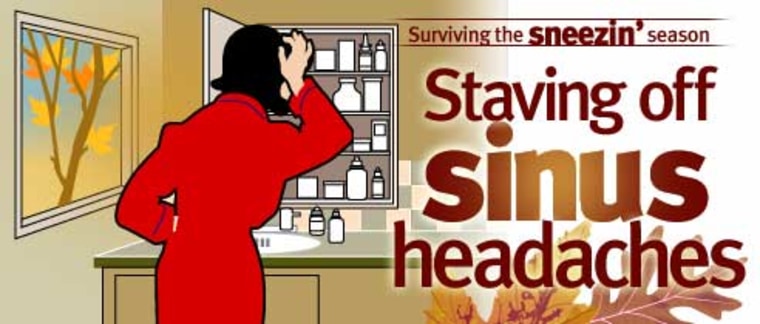Just when the weather starts to cool, your head begins to throb. You wonder if it’s due to stress at work. But if your ears feel swollen and your nose is running, you may have a sinus headache. Every spring and fall, along with sniffling, sneezing and runny noses, come sinus headaches to those with allergies. The headaches are the result of chronic blockage of the sinuses, experts say.
The sinuses are air-filled chambers in your forehead, behind your cheekbones and around your eyes. Like the inside of the nose, they are lined with membranes that produce mucous.
Tiny hair cells, called cilia, constantly pulse, pushing mucous through the sinus cavities into the nose to drain. Normally this keeps the sinuses clear of impurities and bacteria.
But allergies — and infections — can cause the mucous tissues to swell, experts say. And this can result in a blockage of the openings that lead to the nose.
“If this persists over a long period of time you can get chronic sinusitis — a prolonged inflammation of the mucous tissues of the sinuses and the nose,” says Dr. Adrian Casillas, an assistant professor of medicine in the division of clinical immunology and allergy at the University of California, at Los Angeles, School of Medicine. “And that can lead to headaches that are typically located in the forehead above the eyes or at the cheekbones.”
When sinuses behind the nose become inflamed, you end up with pain around your ears, Casillas says. “It’s a similar feeling to the pain you get when you go on an airplane,” he explains.
Allergies or not?
Often, plugged sinuses are due to prolonged exposure to allergens. But sometimes the clogs are the result of a condition known as non-allergic rhinitis.
“In this case, people aren’t allergic, but have symptoms that are like those caused by allergies,” says Dr. Andrea Apter, a professor of medicine at the University of Pennsylvania in Philadelphia. “It’s a chronic nasal condition. We don’t really know what causes it.”
Some people end up with clogged sinuses because they have nasal polyps, Apter says. And some just have hyper-reactive noses that respond poorly to irritants like car exhaust.
The cause can also be bacterial, says Dr. Jeffrey M. Ahn, director of sleep disorder surgery and director of facial plastic and reconstructive surgery at the Columbia Presbyterian Medical Center in New York City. In that case, relief can come from treatment with antibiotics, Ahn says.
And doctors have recently learned that fungi can cause problems. “It’s very much more common than people think,” Ahn says.
In fact, once the sinuses block up — either because of allergies or a cold — they are far more prone to becoming infected with bacteria or fungi.
Finding the right treatment
Ultimately, experts say that to cure the sinus headache, one has to first clear out the sinuses. Decongestants can help with that.
“There are two kinds,” Casillas says. “There are nasal sprays and there are pills, which are systemic. The pills are probably better because the sprays can cause problems in the long run.”
Decongestants help alleviate the blockages by reducing the swelling in the mucous membranes. They do this by diminishing the blood supply to the mucous tissues.
If your doctor determines that you have a bacterial of fungal infection — by doing a culture — you will need antibiotics or an anti-fungal treatment along with the decongestants.
For those who have swollen sinuses due to allergies, a long-term solution will be needed, Casillas says.
“Some people with mild symptoms can pop an antihistamine and that’s enough,” Casillas says. “But others get bad sinusitis. They would benefit from the use of topical steroids or a new class of drugs called leukotriene modifiers.”
Linda Carroll is a free-lance reporter based in New Jersey. Her work has appeared in The New York Times, Health and Smart Money.
